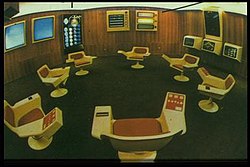Project Cybersyn
From Wikipedia, the free encyclopedia
Project Cybersyn was a Chilean attempt at real-time computer-controlled planned economy in the years 1970–1973 (during the government of president Salvador Allende). It was essentially a network of telex machines that linked factories with a single computer centre in Santiago, which controlled them using principles of cybernetics. The principal architect of the system was British operations research scientist Stafford Beer.
Contents |
[edit] History
In early 1970, Stafford Beer was asked by the newly elected president Salvador Allende to design this system. It took about a year to become operational but it was never completely finished.
The system was most useful in October 1972, when about 50,000 striking truck drivers blocked the access streets that converged towards Santiago. Using the system's telex machines, the government was able to guarantee the transport of food into the city with only about 200 trucks manned by drivers loyal to the government.
After the military coup on September 11, 1973, the control centre was destroyed.
[edit] The system
There were 500 unused telex machines bought by the previous government, each was put into one factory. In the control centre in Santiago, each day data coming from each factory (several numbers, such as raw material input, production output and number of absentees) were put into a computer, which made short-term predictions and necessary adjustments. There were four levels of control (firm, branch, sector, total), with algedonic feedback (if lower level of control didn't remedy a problem in a certain interval, the higher level was notified). The results were discussed in the operations room and the top-level plan was made.
The software for Cybersyn was called Cyberstride, and it used Bayesian filtering and Bayesian control. It was written by Chilean engineers in consultation with a team of 12 British programmers. [1]
The futuristic operations room was designed by a team lead by the interface designer Gui Bonsiepe. It was furnished with seven swivel chairs (considered the best for creativity) with buttons, which controlled several large screens that could project the data, and other panels with status information.
The project is described in some detail in Beer's book Platform for Change, including such social innovations as bringing representatives of diverse 'stakeholder' groups into the control centre.
[edit] References
[edit] See also
- Viable System Model
- History of Chile
- Chilean coup of 1973
- Internet
- Fernando Flores
- ARPANET
- The CyberSyn multimedia "reconstruction"
- Enterprise resource planning
[edit] External links
- Eden Medina, "Designing Freedom, Regulating a Nation: Socialist Cybernetics in Allende's Chile." Journal of Latin American Studies 38 (2006):571-606.
- CyberSyn.cl
- Lecture of Stafford Beer about the system
- Lessons of Stafford Beer
- The picture of the "Operations room"
- The forgotten story of Chile's 'socialist internet'
- Futurism, fictional and science fictional - rambling and inspiring on BoingBoing
- Project Cybersyn | varnelis.net
- Rhizome.org: Project Cybersyn


